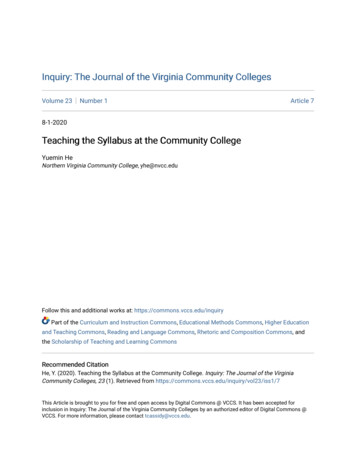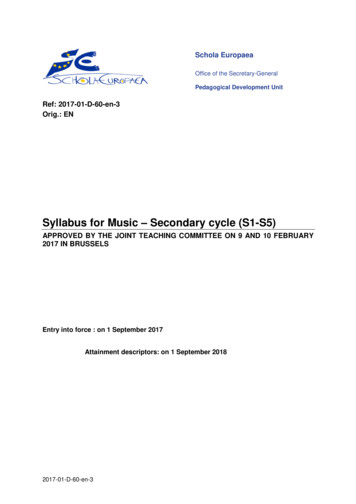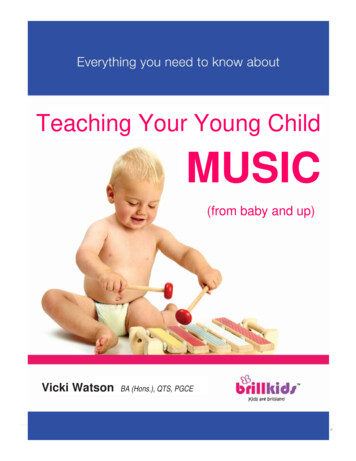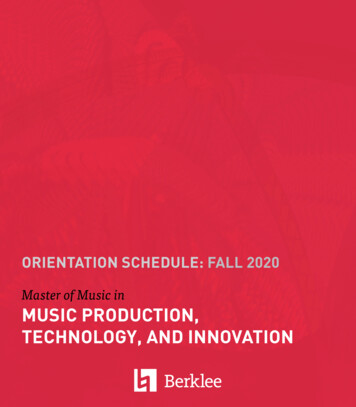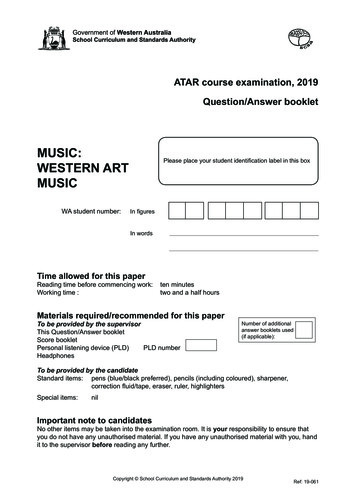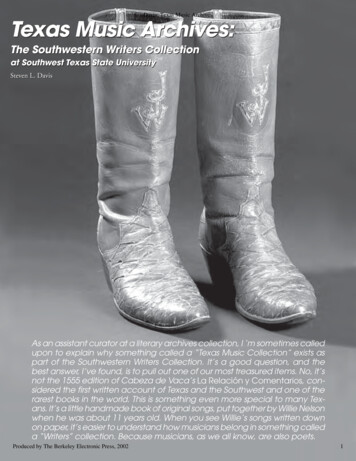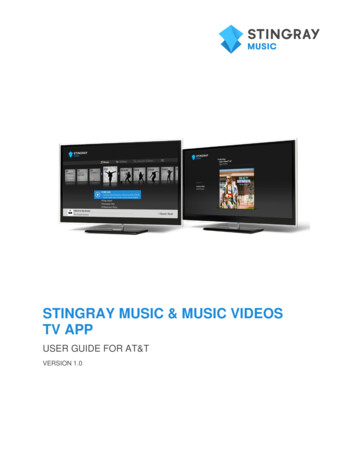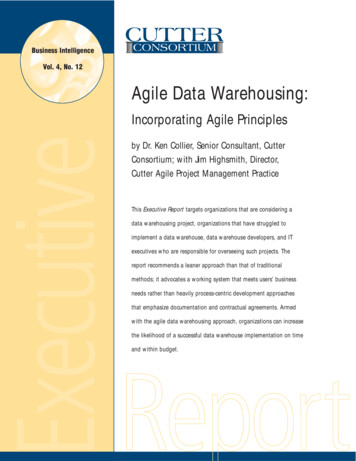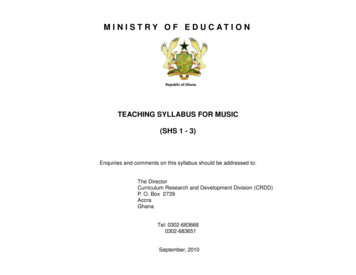
Transcription
M I N I S T R Y O F E D U C AT I O NRepublic of GhanaTEACHING SYLLABUS FOR MUSIC(SHS 1 - 3)Enquiries and comments on this syllabus should be addressed to:The DirectorCurriculum Research and Development Division (CRDD)P. O. Box 2739AccraGhanaTel: 0302-6836680302-683651September, 2010
TEACHING SYLLABUS FOR MUSICRATIONALE FOR TEACHING MUSICMusic permeates the way of life of all cultures. It is an art that is valued and appreciated in every society. Music is performed on various occasions and duringceremonies connected with events such as birth, puberty, marriage, festivals, religious rites and death. Music continues to play a significant role in society byproviding pleasure and enjoyment. It is used for therapeutic purposes in all cultures and provides an outlet for creative expression.Music Education has great potential for job creation. The syllabus therefore emphasises deeper knowledge of the subject through the study of the historical,theoretical, creative and practical aspects of music. The education offered in the subject should equip students with knowledge and practical skills that will enablethem pursue further education in music at the tertiary level where they could prepare themselves to enter the job market as self-employed musicians, (arrangers,composers), dancers, studio engineers, instrument makers, disc jockeys, etc.The purpose of the subject is to:transmit, promote and preserve the music culture of Ghana.help the learner to develop creative compositions and respond imaginatively to music processes and products.provide avenues for self expression.develop skills and aptitudes for acquiring new knowledge as foundation for further education and training.help develop the aesthetic sensitivity of students so that they can make informed choices in life.GENERAL AIMS:The music syllabus is designed to help students to:perform reasonably well as soloists and as members of an ensemble.compose short vocal/instrumental pieces.identify the major characteristics of pieces.appreciate the historical, social and economic factors that have influenced composers and their contributions to the development of music.develop initiative, creativity and resourcefulness in order to contribute to national artistic excellence.equip students with the ability to use and appreciate music through an appreciable understanding of the language of music.acquire skills in reading, writing, listening, improvising and composing.discuss the contributions of selected composers and musicians to the development of music.appreciate and talk intelligently about music.SCOPE OF CONTENTThe music syllabus covers theory of music and composition, performance, appreciation (listening, history and literature); computer application to music andintegration of aspects of regenerative health and nutrition (I.R.H.N.)ORGANISATION AND STRUCTURE OF SYLLABUSThe syllabus provides the organisation and structure of the three-year SHS work in music. Each year’s work has been divided into sections with each sectioncontaining a number of units. A section is based on one of the broad areas in which the syllabus is organized, that is, theory of music and composition,performance and appreciation.SECTION 1: THEORY OF MUSIC AND COMPOSITIONii
General objectives: Students will:1.explore basic elements of music through reading, writing, listening, aural recognition, improvisation and composition.2.acquire skills in self expression through music composition.3.develop skills in critical independent thinking, reasoning and imagination.SECTION 2: PERFORMANCEGeneral objectives: Students will:1.experience the joy in performing music.2.develop skills and artistic confidence in the presentation of music.3.display artistic skills and aesthetic awareness through solo and ensemble performances.SECTION 3: APPRECIATION:General objectives: Students will:1.develop the skills of discriminatory listening and observing.2.perceive the expressive qualities of music.3.develop sensitivity to the expressive qualities of music.4.appreciate the relationships among the organisation of elements in a piece of music.5.appreciate the factors that have influenced composers and their contributions to the development of music in Ghana and the rest of the world.STRUCTURE AND ORGANISATION OF THE MUSIC SYLLABUSTERM 1UNIT/ACTIVITYSHS 1SHS 2SHS 3SECTION 1THEORY OF MUSICAND COMPOSITIONUnit 1: Rudiments and theory of music(Pg. 1-2)Unit 1: Compositional TechniquesUnit 2: Computer Application to Music(PG. 14-15)Unit 1: Compositional TechniquesUnit 2: Computer Application to Music(Pg. 25-26)SECTION 2PERFORMANCEUnit 1: MusicianshipUnit 2: Solo and Ensemble work(Pg. 3)Unit 1: MusicianshipUnit 2: Solo and Ensemble work(Pg. 16)Unit 1: MusicianshipUnit 2: Solo and Ensemble work(Pg. 27-28)SECTION 3APPRECIATION(LISTENING)Unit 1: Aural cultureUnit 2: History and literature of music:Western and Ghanaian artmusic and composersTraditional Ghanaian musiccomposersPopular music in GhanaAfrican music in the DiasporaUnit 3: Form and analysis(Pg. 4)Unit 1: Aural culture.Unit 2: History and literature of music:Western and Ghanaian art musicand composersTraditional Ghanaian musiccomposersPopular music in GhanaAfrican music in the DiasporaUnit 3: Form and analysis(Pg. 17-18)Unit 1: Aural cultureUnit 2: History and literature of music:Western and Ghanaian artmusic and composersTraditional Ghanaian musiccomposersPopular music in GhanaAfrican music in the DiasporaUnit 3: Form and analysis(Pg. 29)iii
STRUCTURE AND ORGANISATION OF THE MUSIC SYLLABUSTERM 2SECTION 1UNIT/ACTIVITYTHEORY OF MUSICAND COMPOSITIONSHS 1Unit 1: Rudiments and theory of musicSHS 2Unit 1: Compositional TechniquesUnit 2: Computer Application to Music(Pg. 5-6)SECTION 2PERFORMANCEUnit 1: MusicianshipUnit 2: Solo and Ensemble work(Pg. 19)Unit 1: MusicianshipUnit 2: Solo and Ensemble work(Pg. 7)SECTION 3APPRECIATION(LISTENING)Unit 1: Aural culture.Unit 2: History and literature of music:Western and Ghanaian artmusic and composersTraditional Ghanaian musiccomposersPopular music in GhanaAfrican music in the DiasporaUnit 3: Form and analysis(Pg. 20)Unit 1: Aural cultureUnit 2: History and literature of music:Western and Ghanaian art musicand composersTraditional Ghanaian musiccomposersPopular music in GhanaUnit 3: African music in the DiasporaUnit 3: Form and analysis(Pg. 21)(Pg. 8)ivSHS 3Unit 1: Compositional TechniquesUnit 2: Computer Application to Music(Pg. 30-31)Unit 1: MusicianshipUnit 2: Solo and Ensemble work(Pg. 32)Unit 1: Aural cultureUnit 2: History and literature of music:Western and Ghanaian artmusic and composersTraditional Ghanaian musiccomposersPopular music in GhanaUnit 3: African music in the DiasporaUnit 3: Form and analysis(Pg. 33-34)
STRUCTURE AND ORGANISATION OF THE MUSIC SYLLABUSTERM 3SECTION 1UNIT/ACTIVITYTHEORY OF MUSICAND COMPOSITIONSHS 1Unit 1: Rudiments and theory of music(Pg. 9-10)SECTION 2PERFORMANCEUnit 1: MusicianshipUnit 2: Solo and Ensemble workSHS 2Unit 1: Compositional TechniquesUnit 2: Computer Application to Music(Pg. 22)Unit 1: MusicianshipUnit 2: Solo and Ensemble work(Pg. 11)SECTION 3APPRECIATION(LISTENING)Unit 1: Aural cultureUnit 2: History and literature of music:Western and Ghanaian artmusic and composersTraditional Ghanaian musiccomposersPopular music in GhanaAfrican music in the DiasporaUnit 3: Form and analysisSHS 3(Pg. 23)Unit 1: Aural cultureUnit 2: History and literature of music –Western and Ghanaian art musicand composersTraditional Ghanaian musiccomposersPopular music in GhanaAfrican music in the DiasporaUnit 3: Form and analysis(Pg. 12-13)(Pg. 24)TIME ALLOCATIONMusic is allocated seven (6) periods a week, each of forty (40) minutes duration.PRE-REQUISITE SKILLSStudents have already been exposed to musical activities at the pre-school and basic school levels, in the church and at home. The pre-requisite skills for the study of musictherefore include reasonably good performance at the Basic Education level and the love for music.SUGGESTIONS FOR TEACHING THE SYLLABUSGENERAL OBJECTIVESGeneral objectives have been listed at the beginning of each section of the syllabus, that is, just below the theme of the section. The general objectives specify the skills andbehaviours the student should acquire after learning the units of a section. They therefore form the basis for the selection and organisation of the unit topics in the section.Read the general objectives very carefully before you start teaching the section. After teaching all the units, go back and read the general aims and general objectives again to besure you have covered both of them adequately in the course of your teaching.Sections and units: The music syllabus has been planned on the basis of sections and units. Each year’s work has been divided into three sections representing theory of music andcomposition, performance and appreciation (listening). A section consists of a fairly homogenous body of knowledge within the subject. Within each section are units. A unit consistsof a more related and more homogenous body of knowledge and skills that form the logical aspect of the section. The teacher is expected to consider the total number of sectionsv
and associated number of units prescribed for the year and plan his/her lessons for each term such that the work in all the sections and units for each particular class will beadequately completed by the end of the school year.Each section of the syllabus is structured in five columns: units, specific objectives, content, teaching and learning activities and evaluation. A description of the contents of eachcolumn is as follows:Column 1 – Units: The units in column 1 are divisions of the major topics of the section. The teacher is expected to follow the unit topics according to the sequential order in whichthey have been presented. However, if the teacher finds at some point that teaching and learning in his/her class will be more effective if he/she branched to another unit beforecoming to the unit in the sequence he/she is encouraged to do so.Column 2 – Specific Objectives: Column 2 shows the specific objectives for each unit. The specific objectives begin with numbers such as 1.2.2 or 2.2.1. These numbers arereferred to as “syllabus reference numbers”. The first digit in the syllabus reference number refers to the section; the second digit refers to the unit, while the third digit refers to thesequence order of the specific objectives. For instance, 1.2.2 means section 1, unit 2 (of section 1) and specific objective 2. In other words, 1.2.2 refers to specific objective 2 of unit2 of section 1. Similarly, the syllabus reference number 2.2.1 simply means specific objective number 1, of unit 2 of section 2. Using syllabus reference numbers provides an easyway for communication among teachers and other educators. It further provides an easy way for selecting objectives for test construction. For instance, if unit 2 of section 2 has fivespecific objectives: 2.2.1 – 2.2.5, a teacher may want to base his/her test items/questions on objectives 2.2.3 and 2.2.4 and not use the other three objectives. In this way a teacherwould sample the objectives within units and within sections to be able to develop a test that accurately reflects the importance of all the various skills taught in class.You will note also that specific objectives have been stated in terms of the students, that is, what the student will be able to do after instruction and learning in the unit. Each specificobjective hence starts with the following “ the student will be able to”. This in effect means that the teacher has to address the learning problems of each individual student. It meansthat the teacher has to individualise his/her instruction as much as possible such that the majority of students will be able to master the objectives of each unit of the syllabus. Eachspecific objective contains an action verb that indicates the type of behaviour or dimension that teaching and learning should promote.As has been said already, the order in which the unit topics appear should not necessarily be the teaching order. There should, however, be a linkage in the order in which the unitsand specific objectives are treated. The teacher will have to study the syllabus carefully and plan ahead the activities the students will carry out during a particular lesson. Knowingthe requirements of a lesson, the teacher should assemble the teaching and learning materials required for the activities well in advance.Column 3 – ContentThe content in the third column of the syllabus presents a selected body of information that the teacher needs to use in teaching the particular unit. In some cases, the contentpresented is quite exhaustive. In some other cases the teacher could add more information to the content presented.Column 4 – Teaching and Learning ActivitiesTeaching and learning activities that will ensure maximum participation by every student are presented in column 4. The teacher should do away with rote learning of concepts anddrill oriented methods and rather emphasize participatory teaching and learning and also emphasize the cognitive, affective and psychomotor domains of knowledge in his/herinstructional system wherever appropriate. The teacher is encouraged to reorder the suggested teaching and learning activities and also add to them where necessary in order toachieve optimum students’ learning.The teacher should involve students in creating, performing, listening and talking about their own works. Developing skills of self-critiquing is critical to nurturing creativity in students.Teachers should not limit themselves to the activities suggested in the syllabus. They should be innovative and add to the suggested activities. They are also encouraged to try outentirely new learning and teaching activities based on the specific objectives.Column 5 – EvaluationSuggestions and exercises for evaluating the lessons of each unit are indicated in column 5. Evaluation exercises can be in the form of oral questions, quizzes, class assignments,demonstrations, project work, etc. The teacher should try to ask questions and set tasks and assignments that will challenge his/her students to develop their creative skills in music.The suggested evaluation tasks are not exhaustive. The teacher is encouraged to develop other practical and creative evaluation tasks to ensure that students have mastered theinstruction and behaviours implied in the specific objectives of each unit.A list of books that may help expand the teacher’s knowledge in music has been provided in Appendix D. The list is not exhaustive and teachers must add to the collection anymaterials that they find relevant. In addition, teacher’s own personal knowledge of music should be utilised in class teaching.vi
The teacher should note that the syllabus should not be taken as a substitute for lesson plans. It is therefore, necessary that he/she develops a scheme of work and lesson plans forteaching the units of this syllabus.NOTES TO THE TEACHERPractical activities (skills) must be given 70 per cent of the teaching and learning time to emphasise the point that music is more toward the acquisition of practical skills incomposition, performance and aural culture at the high school level. The remaining 30 per cent can be used for theoretical aspect of music such as the history and literature, andrudiments and theory.Words involved in each of the dimensions and their explanation are as follows:Knowledge and Understanding (KU)KnowledgeThis is the ability to remember, recall, identify, define, describe, list, name, match, state principles, facts and concepts. Knowledge is, therefore, simply the abilityto remember or recall material already learned and constitutes the lowest level of learning.UnderstandingThis is the ability to explain, summarise, translate, rewrite, paraphrase, give examples, generalise, estimate or predict consequences based upon trend.Understanding is generally the ability to grasp the meaning of some material that may be verbal, pictorial, or symbolic.Application of knowledge (AK)The ability to use or apply knowledge, as implied in this syllabus, has a number of learning/behaviour levels. These levels include application, analysis, innovation or creativity, andevaluation. These may be considered and taught separately, and you should reflect each of them equally in your teaching. The dimension “Use of Knowledge” is a summarydimension for all four learning levels. Details of each of the sub-levels are as follows:ApplicationThis is the ability to apply rules, methods, principles, theories, etc. to concrete situations that are new and unfamiliar. It also involves the ability toproduce, solve, operate, demonstrate, discover, etc.AnalysisThis is the ability to break down materials into its component parts; to differentiate, compare, distinguish, outline, separate, identify significant points,recognize unstated assumptions and logical facilities, recognise inferences from facts etc.Innovation/Creativity-The ability to put parts together to form a new whole. It involves the ability to synthesize, combine, compile, compose, devise, suggest anew idea or possible ways, plan, revise, design, organize, create, and generate new solutions. The ability to create or innovate is thehighest form of learning. The world becomes more comfortable because some people, based on their learning, design and create newthings, new ideas and new music.EvaluationThe ability to appraise, compare features of different things and make comments or judgments, contrast, criticize, justify, support, discuss,conclude, make recommendations etc. Evaluation refers to the ability to judge the worth or value of some materials, ideas etc., based onsome criteria. Evaluation is a constant decision making activity. We generally compare, appraise and select throughout the day. Everydecision we make involves evaluation. Evaluation is a high level ability just as application, analysis and innovation or creativity since itgoes beyond simple knowledge acquisition and understanding.vii
DEFINITION OF PROFILE DIMENSIONS The word Profile means a description of the abilities of an individual. In teaching, we measure the behavioural change in learners. These changes are measured in terms of what the learner can do after going through the teaching andlearning process, or is able to do after instruction. It is also a learning behaviour.Learning should result in an observable change in behaviour. The behavioural changes can be exhibited as follows: The acquisition of knowledge – The student is able to remember or recall, name, list, state principles and facts; understanding – explain, summarise, translate, rewrite, give examples etc Ability to use the knowledge acquired-Application. The pupil is able to apply rules, principles and theories, ability to produce, solve, plan, demonstrate and discover, etc. The ability to break down material into its component parts- AnalysisThe pupil will be able to differentiate, compare, distinguish, outline, give reasons, recognise unstated assumptions and make inferences from facts, etc. The ability to synthesize or put ideas, techniques etc together to form a new thing, a new piece of music etc – Innovation/CreativityThe pupil will be able to combine, compile, compose, plan, generate new ideas, devise, design, organise, create, etc. Evaluation The pupil will be able to appraise, compare features of different things and make decisions, make comments and judgments, criticise, justify, support, discuss,make recommendations, etc.Any of these behaviours is referred to as a Dimension. A dimension is, therefore, a psychological unit for describing a particular learning behaviour. Two or more of thesedimensions is referred to as the Profile of dimensions. For example, a combination of knowledge and comprehension (understanding).Profile dimensions are categorized into two1. Lower Level Dimensions or Behaviours2. Higher Level Dimensions or Behaviours1. Lower Level Dimensions or Behaviours: Knowledge and understanding are classified as Lower Level Dimensions. Knowledge involves pure recall of information, data and principles learnt in school.2. Higher Level Dimensions or Behaviours These involve the use of knowledge such as application, analysis, innovation or creativity and evaluation.Weighting the DimensionsIn teaching, learning, and assessment, each dimension has been given a percentage weight. The weight shows the emphasis placed on each dimension, e.g. In Music, the threeprofile dimensions specified for teaching, learning and assessment are as follows:1. Creativity: Creativity is the ability to produce novel work that is accepted as tenable, useful or satisfying by a group at some point in time. Creativity includes novel composition,improvisation, originality, recreation and interpretation of existing works in different ways.2. Aesthetic: Sensitivity: Aesthetic sensitivity concerns the individual’s response to the expressive qualities of music. It involves the development of an attitude which promotesinitiative and the desire to continue to participate in and value music. Aesthetic sensitivity is an “affective quality” which consists of a number of learning andbehavioural levels such as receiving, responding, valuing and organising. The specific behaviours in each of the four levels are as follows:Receiving: The ability to follow direction, listen to music, show awareness and sensitivity, accept, ask questions on music, give information on music, etc.Responding: The ability to participate in music, assist, conform, enjoy music, present, and show interest, volunteer for duties connected with music.Valuing: The ability to demonstrate attitudes, beliefs, one’s worth, initiate, invite, propose, report, share, work, read music.Organising: The ability to assimilate new and different values, and to form a new and consistent value system. It refers to the ability to accept, alter, defend, arrange,formulate, generalise, modify, and defend a piece of music or a presentation of music.3.Perception: Perception is the knowledge and ability to identify and isolate the organisation of elements in an existing or a spontaneous creative work. It involves the ability tointernalise concepts and break down a piece of material into its component parts, to differentiate, to compare, distinguish, outline, separate, identify significant points,etc.viii
Each of the dimensions has been given a percentage weight that should be considered in teaching, learning and assessment. The weights indicated in column 2 of Table 1 belowshow the relative emphasis that the teacher should give in the teaching, learning and assessment processes.Table 1:DIMENSIONPERCENTAGE WEIGHTCreativity40Aesthetic sensitivity30Perception30TOTAL100Table 2 below shows details of the percentage weight of each of the three components or sections of the music syllabus. It also shows the weights of the profile dimensions for eachof them.Table 2DimensionTheory and Aesthetic e of assessmentIt is important to note that both instruction and assessment in music should be based on the profile dimensions of the subject. In developing assessment procedures, the teachershould select specific objectives in such a way that he or she will be able to assess a representative sample of the objectives of the syllabus. Each specific objective in the syllabusis considered a criterion to be achieved by the student. When the teacher develops a test that is made up of items that are based on a representative sample of the specificobjectives taught, the test is referred to as “Criterion-Referenced Test”. In many cases, the teacher may not be able to test all the objectives taught in a term, in a year, etc. Theassessment procedure the teacher uses i.e. class tests, home work, projects, etc. must be developed in such a way that it will consist of a sample of the important objectives taughtover a period.An example of an examination will consist of three papers, Paper 1A, 1B and Paper 2A, 2B. Paper 1A will be an aural test consisting of melodic dictation, rhythmic dictation,identification of chords, cadences, modulations, themes from excerpts of music; Paper 1B will be a performance test based on principal instrument selected by the student. Theitems for this test will comprise technical exercises, sight reading, at least two music pieces chosen by the student; Paper 2A will consist of multiple objective tests based onrudiments and theory of music, history and literature of music, setting words to music, composition, analysis of a piece of music, and biographies of composers and theircontributions to the growth and development of music. Paper 2B will be made up of a project in Composition which candidates will present for final assessment. That is eachcandidate will have to compose a piece of music in any category (Traditional, Highlife, Gospel, Art music, etc). The distribution of marks for the test items in the four papers shouldbe in line with the weights of the profile dimensions already indicated.ix
In the sample assessment structure presented above, Paper 1A is marked 40 marks; Paper 1B is marked out of 60 marks; Paper 2 is 100 marks. The end of term marks (200)constitutes 70% of the final examination mark whilst School Based Assessment makes up the remaining 30%.GUIDELINES FOR SCHOOL-BASED ASSESSMENT (SBA)A new School Based Assessment system (SBA) will be introduced into the school system in 2011. The new SBA system is designed to provide schools with aninternal assessment system that will help schools to achieve the following purposes:oooooooStandardize the practice of internal school-based assessment in all Senior High Schools in the countryProvide reduced assessment tasks for subjects studied at SHSProvide teachers with guidelines for constructing assessment items/questions and other assessment tasksIntroduce standards of achievement in each subject and in each SHS classProvide guidance in marking and grading of test items/questions and other assessment tasksIntroduce a system of moderation that will ensure accuracy and reliability of teachers’ marksProvide teachers with advice on how to conduct remedial instruction on difficult areas of the syllabus to improve class performance.The arrangement for SBA may be grouped in categories as follows. Folio Preparation, Project designed to include folio preparation, Mid-Term test, GroupExercise and End of Term Examination.Folio Preparation: Folio preparation may include the following: Investigative study and field visit reportsProject: This will consist of a selected topic to be carried out by groups of students for a year. Segments of the project will be carried out each term toward the finalproject completion at the end of the year,Mid-Term Test: The mid-term test following a prescribed format will form part of the SBAGroup Exercise: This will consist of written assignments or practical work on a topic(s) considered important or complicated in the term’s syllabusEnd-of-Tem Examination: The end-of-term test is a summative assessment system and should consist of the knowledge and skills students have acquired in theterm. The end-of-term test for Term 3 for example, should be composed of items/questions based on the specific objectives studied over the three terms,using a different weighting system such as to reflect the importance of the work done in each term in appropriate proportions. For example, a teacher maybuild an End-of-Term 3 test in such a way that it would consist of the 20% of the objectives studied in Term 1, 20% of objectives studied in Term 2 and60% of the objectives studied in Term 3.x
GRADING PROCEDURETo improve assessment and grading and also introduce uniformity in schools, it is recommended that schools adopt the following WASSCE grade structure forassigning grades on students’ test results. The WASSCE structure is as follows:Grade A1:Grade B2:Grade B3:Grade C4:Grade C5:Grade C6:Grade D7:Grade D8:Grade F9:80 - 100%70 - 79%60 - 69%55 - 59%50 - 54%45 - 49%40 - 44%35 - 39%34% and below-ExcellentVery GoodGoodCreditCreditCreditPassPassFailIn assigning grades to students’ test results, you are encouraged to apply the above grade boundaries and the descriptors which indicate the meaning of eachgrade. The grade boundaries i.e., 60-69%, 50-54% etc., are the grade cut-off scores. For instance, the grade cut-off score for B2 grade is 70-79% in the example.When you adopt a fixed cut-off score grading system as in this example, you are using the criterion-referenced grading system. By this system a student mustmake a specified score to be awarded the requisite grade. This system of grading challenges students to study harder to earn better grades. It is hence a veryuseful system for grading achievement tests.Always remember to develop and use a marking scheme for marking your class examination scripts. A marking scheme consists of the points for the best answeryou expect for each question, and the marks allocated for each point raised by the student as well as the total marks for the question. For instance, if a questioncarries 20 marks and you expect 6 points in the best answer, you could allocate 3 marks or part of it (depending upon the quality of the points raised by thestudent) to each point , hence totaling 18 marks, and then give the remaining 2 marks or part of it for organization of answer. For objective test papers you maydevelop an answer key to speed up the marking.xi
SENIOR HIGH SCHOOL - YEAR 1 - TERM 1SECTION 1THEORY OF MUSIC AND COMPOSITIONGeneral Objectives: The student will:1.2.3.UNITexplore basic elements of music through reading, writing, listening, aural recognition,improvisation and composition.acquire skills in self expression through music composition.develop skills in critical, independent thinking, reasonin
TEACHING SYLLABUS FOR MUSIC RATIONALE FOR TEACHING MUSIC Music permeates the way of life of all cultures. It is an art that is valued and appreciated in every society. Music is performed on various occasions and during ceremonies connected with events such as birth,

